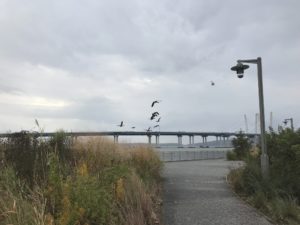
The debate about climate change has been increasingly difficult to ignore, but sometimes lost in the larger discussion is how changing weather patterns affect our daily lives. Many scientists now caution us about rising sea levels and inland flooding. With the goal of examining such events, The Nature Conservancy in conjunction with the Hudson River Watershed Alliance, Hudson River Estuary Program, NYS DEC, and the Land Trust Alliance held a “Community Resilience Building Workshop” for community groups at the Tarrytown Senior Center on September 26. Even if you don’t believe in climate change—or feel its consequences are exaggerated—the workshop still provided invaluable information about flooding and large storms. To restore your affected property, you can see more information here.
“What the intent of the workshop is for multiple members to sit and have a conversation about what assets of the community are important,” said Andy Peck, Freshwater Ecologist and Resilience Specialist at The Nature Conservancy, one of the largest environmental organizations in the world with more than a million members and more than 400 scientists working on conservation projects in 72 countries on six continents. On its website (nature.org), the Conservancy states its mission as “working in partnership with individuals, local communities, government agencies and private businesses to protect the natural landscapes that harbor the diversity of plant and animal life on Earth.”
Peck’s position there is more focused on local work. As he told The River Journal, “I manage our Hudson River interactions, statewide climate resilience, and climate change adaptation.” This brought him to the Tarrytown workshop, where attendees included representatives from local and county departments including emergency response; water; transportation; planning; conservation advisory committees; mayors and trustees; and other government entities from Tarrytown, Sleepy Hollow, Irvington, Dobbs Ferry, and Hastings.
“We’re focused on sustainable water use,” he said. “We’re also looking at how we can work with communities to adapt to changing climate in terms of making sure our natural systems are functioning as they should and hopefully in ways that are protecting people from impending damage.”
Peck described the workshop as an information-building project designed to start a conversation about how to be prepared for events such as flooding. He said the first step was to discuss infrastructure like roads, power lines, water supply systems, and drinking water systems. Then they identified emergency system plans, shelter areas, and nonprofit organizations like the Red Cross that help during times of need. They also spoke about potential hazards to parks, and flood areas along rivers, streams, lakes, etc.
Peck stressed the importance for leaders to recognize “what are the assets of the community that are important.” This includes high-risk places like hospitals and schools. He added, “Tarrytown, for example, has several facilities that are recreational centers, senior centers, police departments, VFWs, and the town hall that are all located by the river. So, during a storm surge, there’s a certain danger to these structures. The question and dialogue becomes what are we going to do about them? Are we going to leave them in place, or can we modify what those facilities are and how we use them? Can they be operating after the water leaves in a reasonable amount of time? Or are we going to pick up and move some of these facilities and relocate them somewhere out of harm’s way.”
After those gathered at the workshop identified community assets, they determined if such locations are publicly-owned or privately-owned, and whether they are considered strengths or vulnerabilities. Peck said, “Sometimes, one asset can be both. When we say ‘strength,’ we mean something the community relies on during difficult times, or something they use to respond to events that actually gets damaged like a bridge along a creek. If it gives out during a flood, then that street crossing is a vulnerability because not only does the structure get washed out or become unusable, it may isolate communities from 911 services.”
Another goal of the workshop was for the dialogue to stretch across the multiple communities represented, so that neighboring villages can pool their resources to save lives and properties. While The Nature Conservancy offers some suggestions for resolutions, they intend for it to be just a facilitation of a conversation. Afterward, they produced a summary of the workshop for attendees to use as a guide on what can be done immediately to implement improvements.
The workshop was held mere days after 16-year-old Swedish activist Greta Thunberg
delivered a passionate speech at the U.N. climate summit that captured the concerns that many people, especially younger generations, feel. Peck said it’s hard not to notice the changes to climate all around us. “We are seeing flooding more frequently with higher water levels than we have in the past. Many of our communities are recognizing this and are already taking steps to reduce their risk, but the risk many communities—like the ones along the Hudson—face are extreme,” he said. “They are very sensitive and they are going to take time.”
Photos here: https://tnc.box.com/s/9tduk7a0da5fv6xeogn24pspr05lhmeh
Photo credit: Emily Vail and the Hudson River Watershed Alliance (HRWA)






